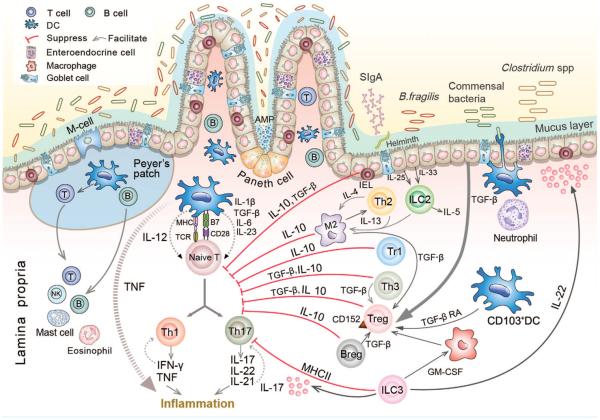Figure 1.
Microbiota and immune regulatory cells in gut. Schematic shows the location of immune regulatory cells and other immune cells and their signaling cascades in the lamina propria of gut. The luminal microbiome lies adjacent to the intestinal epithelium. The microbiota plays an important role in the maintenance of mucosa homeostasis. Breach of the tolerance leads to the development of inflammatory bowel diseases (IBD), inflammation, and tumor. Intestinal epithelial barrier is the first line of defense to prevent the pathogens invasion, including the epithelial tight junction complexes, mucus layer secretion by goblet cell, secretory immunoglobulin A (sIgA), antimicrobial protein (AMP) secretion by plasma cells, and Paneth cells. With regard to the innate immune response in intestine, neutrophils could be earlier recruited to inflammatory sites to clear the pathogens. In addition, macrophages, dendritic cells (DCs), and innate lymphoid cells (ILCs) could sense antigens and then secrete cytokines or chemokines to regulate the inflammatory responses. Some innate immune regulatory cells such as M2 induced by interleukin (IL)-4 and IL-13 could directly inhibit effector T cells through IL-10 secretion and promote regulatory T cell (Treg) suppressive function by producing transforming growth factor-β (TGF-β). CD103+ DCs could regulate intestinal inflammation via facilitating Treg differentiation in a TGF-β- and retinoic acid (RA)-dependent manner. ILC3 serve as an antigen-presenting cell (APC) that uniquely restrain the CD4+ T-cell response in a major histocompatibility complex (MHC) II-dependent manner, and could secrete IL-22 that participates in the repair of impaired epithelium. In response to epithelium-derived IL-25 and IL-33, ILC2 could produce IL-5 and IL-13 to play the role of anti-helminth. The primarily regulatory cells are Tregs that suppress effector T-cell differentiation and proliferation by producing IL-10 and TGF-β or expressing CD152. The IL-10-producing type 1 regulatory T (Tr1) cells perform the anti-inflammatory function. Moreover, T helper type 3 (Th3) cells, regulatory B cells (Bregs), and intraepithelial lymphocytes (IELs) have the capacity of suppressing the excessive Th1 and Th17 responses through IL-10 and TGF-β production. Therefore, these immune regulatory cells collectively maintain the intestinal homeostasis by interacting with each other.

